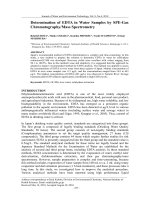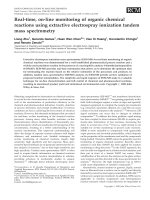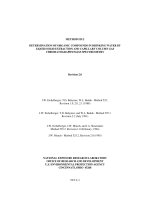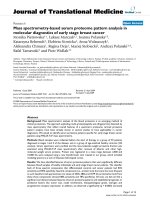Fundamentals of contemporary mass spectrometry
Bạn đang xem bản rút gọn của tài liệu. Xem và tải ngay bản đầy đủ của tài liệu tại đây (6.06 MB, 610 trang )
www.pdfgrip.com
FUNDAMENTALS
OF CONTEMPORARY
MASS SPECTROMETRY
CHHABIL DASS
University of Memphis
A JOHN WILEY & SONS, INC., PUBLICATION
www.pdfgrip.com
www.pdfgrip.com
FUNDAMENTALS
OF CONTEMPORARY
MASS SPECTROMETRY
www.pdfgrip.com
www.pdfgrip.com
FUNDAMENTALS
OF CONTEMPORARY
MASS SPECTROMETRY
CHHABIL DASS
University of Memphis
A JOHN WILEY & SONS, INC., PUBLICATION
www.pdfgrip.com
Copyright © 2007 by John Wiley & Sons, Inc. All rights reserved.
Published by John Wiley & Sons, Inc., Hoboken, New Jersey.
Published simultaneously in Canada.
No part of this publication may be reproduced, stored in a retrieval system, or transmitted in any
form or by any means, electronic, mechanical, photocopying, recording, scanning, or otherwise,
except as permitted under Section 107 or 108 of the 1976 United States Copyright Act, without
either the prior written permission of the Publisher, or authorization through payment of the
appropriate per-copy fee to the Copyright Clearance Center, Inc., 222 Rosewood Drive, Danvers,
MA 01923, (978) 750-8400, fax (978) 750-4470, or on the web at www.copyright.com. Requests
to the Publisher for permission should be addressed to the Permissions Department, John Wiley &
Sons, Inc., 111 River Street, Hoboken, NJ 07030, (201) 748-6011, fax (201) 748-6008, or online at
/>Limit of Liability/Disclaimer of Warranty: While the publisher and author have used their best
efforts in preparing this book, they make no representations or warranties with respect to the
accuracy or completeness of the contents of this book and specifically disclaim any implied
warranties of merchantability or fitness for a particular purpose. No warranty may be created or
extended by sales representatives or written sales materials. The advice and strategies contained
herein may not be suitable for your situation. You should consult with a professional where
appropriate. Neither the publisher nor author shall be liable for any loss of profit or any other
commercial damages, including but not limited to special, incidental, consequential, or other
damages.
For general information on our other products and services or for technical support, please contact
our Customer Care Department within the United States at (800) 762-2974, outside the United
States at (317) 572-3993 or fax (317) 572-4002.
Wiley also publishes its books in a variety of electronic formats. Some content that appears in print
may not be available in electronic formats. For more information about Wiley products, visit our
web site at www.wiley.com.
Wiley Bicentennial Logo: Richard J. Pacifico
Library of Congress Cataloging-in-Publication Data:
Dass, Chhabil.
Fundamentals of contemporary mass spectrometry / Chhabil Dass.
p. cm.
Includes bibliographical references.
ISBN 978-0-471-68229-5
1. Mass spectrometry. 2. Spectrum analysis—Instruments. 3. Molecular spectroscopy. 4.
Biomolecules—Analysis. I. Title.
QC454.M3D37 2007
543 .65—dc22
2006027635
Printed in the United States of America
10 9 8 7 6 5 4 3 2 1
www.pdfgrip.com
Dedicated to All My Teachers
www.pdfgrip.com
www.pdfgrip.com
CONTENTS
PREFACE
xix
I INSTRUMENTATION
1
1 BASICS OF MASS SPECTROMETRY
3
1.1
1.2
1.3
1.4
1.5
Brief History of Mass Spectrometry
Desirable Features of Mass Spectrometry
Basic Principles of Mass Spectrometry
Anatomy of a Mass Spectrum
Atomic and Molecular Masses
1.5.1 Mass-to-Charge Ratio
1.6 General Applications
Overview
Exercises
References
2 MODES OF IONIZATION
2.1 Why Ionization Is Required
2.2 General Construction of an Ion Source
Gas-Phase Ionization Techniques
2.3 Electron Ionization
3
5
5
7
9
10
11
12
12
13
15
15
16
17
17
vii
www.pdfgrip.com
viii
CONTENTS
2.4 Chemical Ionization
2.4.1 Charge-Exchange Chemical Ionization
2.4.2 Negative-Ion Chemical Ionization
2.5 Photoionization
2.6 Field Ionization
2.7 Metastable Atom Bombardment Ionization
Condensed-Phase Ionization Techniques: Ionization
of Solid-State Samples
2.8 Field Desorption
2.9 Plasma Desorption Ionization
2.10 Secondary-Ion Mass Spectrometry
2.11 Fast Atom Bombardment
2.12 Laser Desorption/Ionization
2.13 Matrix-Assisted Laser Desorption/Ionization
2.13.1 MALDI Analysis of Low-Molecular-Mass
Compounds
2.13.2 Atmospheric-Pressure MALDI
2.13.3 Surface-Enhanced Laser Desorption/Ionization
2.13.4 Material-Enhanced Laser Desorption/Ionization
Condensed-Phase Ionization Techniques: Ionization
of Liquid-State Samples
2.14 Thermospray Ionization
2.15 Atmospheric-Pressure Chemical Ionization
2.16 Atmospheric-Pressure Photoionization
2.17 Electrospray Ionization
2.17.1 Mechanism of Electrospray Ionization
2.17.2 Sample Consideration
2.17.3 Nanoelectrospray Ionization
2.18 Desorption Electrospray Ionization
2.18.1 DART Ion Source
Overview
Exercises
Additional Reading
References
3 MASS ANALYSIS AND ION DETECTION
3.1 Mass Resolving Power
3.2 Kinetic Energy of Ions
Mass Analyzers
20
24
25
26
28
28
29
29
30
31
32
35
35
42
43
44
45
45
45
46
47
48
52
54
54
55
56
57
58
60
60
67
68
70
70
www.pdfgrip.com
CONTENTS
3.3 Magnetic-Sector Mass Spectrometers
3.3.1 Working Principle of a Magnetic Analyzer
3.3.2 Working Principle of an Electrostatic Analyzer
3.3.3 Working Principle of Double-Focusing
Magnetic-Sector Mass Spectrometers
3.3.4 Performance Characteristics
3.4 Quadrupole Mass Spectrometers
3.4.1 Working Principle
3.4.2 Performance Characteristics
3.4.3 RF-Only Quadrupole
3.5 Time-of-Flight Mass Spectrometers
3.5.1 Working Principle
3.5.2 Delayed Extraction of Ions
3.5.3 Reflectron TOF Instrument
3.5.4 Orthogonal Acceleration TOF Mass Spectrometer
3.5.5 Performance Characteristics
3.6 Quadrupole Ion-Trap Mass Spectrometers
3.6.1 Working Principle
3.6.2 Operational Modes
3.6.3 Performance Characteristics
3.7 Linear Ion-Trap Mass Spectrometers
3.7.1 Rectilinear Ion Trap
3.8 Fourier-Transform Ion Cyclotron Resonance Mass
Spectrometers
3.8.1 Working Principle
3.8.2 Performance Characteristics
3.9 Orbitrap Mass Analyzers
3.10 Ion Mobility Mass Spectrometers
3.11 Detectors
3.11.1 Faraday Cup Detector
3.11.2 Electron Multipliers
3.11.3 Photomultiplier Detectors
3.11.4 Postacceleration Detectors
3.11.5 Low-Temperature Calorimetric Detectors for
High-Mass Ions
3.11.6 Focal-Plane Detectors
Overview
Exercises
ix
70
70
73
73
74
75
76
79
80
80
81
83
84
85
86
86
87
89
90
92
94
94
95
98
99
101
103
103
104
105
105
106
107
108
110
www.pdfgrip.com
x
CONTENTS
Additional Reading
References
4 TANDEM MASS SPECTROMETRY
4.1 Basic Principles of Tandem Mass Spectrometry
4.2 Types of Scan Functions
4.3 Ion Activation and Dissociation
4.3.1 Collision-Induced Dissociation
4.3.2 Surface-Induced Dissociation
4.3.3 Absorption of Electromagnetic Radiations
4.3.4 Electron-Capture Dissociation
4.4 Reactions in Tandem Mass Spectrometry
4.5 Tandem Mass Spectrometry Instrumentation
4.5.1 Magnetic-Sector Tandem Mass Spectrometers
4.5.2 Tandem Mass Spectrometry with
Multiple-Quadrupole Devices
4.5.3 Tandem Mass Spectrometry with Time-of-Flight
Instruments
4.5.4 Tandem Mass Spectrometry with a Quadrupole
Ion-Trap Mass Spectrometer
4.5.5 Tandem Mass Spectrometry with an FT–ICR
Mass Spectrometer
4.5.6 Tandem Mass Spectrometry with
Hybrid Instruments
Overview
Exercises
Additional Reading
References
5 HYPHENATED SEPARATION TECHNIQUES
5.1 Benefits of Coupling Separation Devices with Mass
Spectrometry
5.2 General Considerations
5.2.1 Characteristics of an Interface
5.2.2 Mass Spectral Data Acquisition
5.2.3 Characteristics of Mass Spectrometers
5.3 Chromatographic Properties
5.4 Gas Chromatography/Mass Spectrometry
5.4.1 Basic Principles of Gas Chromatography
112
112
119
119
121
123
124
125
126
127
128
129
129
132
133
136
138
138
143
145
146
146
151
152
153
153
153
155
155
158
158
www.pdfgrip.com
CONTENTS
5.5
5.6
5.7
5.8
5.9
5.10
5.11
5.4.2 Interfaces for Coupling Gas Chromatography with
Mass Spectrometry
Liquid Chromatography/Mass Spectrometry
5.5.1 Basic Principles of HPLC Separation
5.5.2 Fast-Flow Liquid Chromatography
Interfaces for Coupling Liquid Chromatography with Mass
Spectrometry
5.6.1 Moving-Belt Interface
5.6.2 Direct-Liquid Introduction Probe
5.6.3 Continuous-Flow Fast Atom Bombardment Interface
5.6.4 Thermospray Interface
5.6.5 Particle–Beam Interface
5.6.6 Electrospray Ionization Interface
5.6.7 Atmospheric-Pressure Chemical Ionization Interface
5.6.8 Atmospheric-Pressure Photoionization Interface
5.6.9 Coupling LC with TOF–MS
5.6.10 Coupling LC with MALDI–MS
Multidimensional LC/MS
Capillary Electrophoresis/Mass Spectrometry
5.8.1 Basic Principles of Capillary Electrophoresis
5.8.2 Interfaces for Coupling Capillary Electrophoresis
with Mass Spectrometry
Affinity Chromatography/Mass Spectrometry
Supercritical-Fluid Chromatography/Mass Spectrometry
Coupling Planar Chromatography with Mass Spectrometry
Overview
Exercises
Additional Reading
References
xi
159
161
161
162
163
164
165
165
166
167
168
171
171
171
172
173
174
175
177
181
183
183
185
186
187
187
II ORGANIC AND INORGANIC MASS SPECTROMETRY 195
6 ORGANIC MASS SPECTROMETRY
6.1 Determination of Molecular Mass
6.1.1 Molecular Mass Measurements at Low-Mass
Resolving Power
6.1.2 Molecular Mass Measurements at High-Mass
Resolving Power
6.1.3 Molecular Mass Measurements by ESI and MALDI
197
198
198
198
200
www.pdfgrip.com
xii
CONTENTS
6.2
6.3
6.4
6.5
6.6
6.7
6.8
6.1.4 Mass Calibration Standards
Molecular Formula from Accurate Mass Values
Molecular Formula from Isotopic Peaks
General Guidelines for Interpretation of a Mass Spectrum
6.4.1 Odd- and Even-Electron Ions
6.4.2 Recognizing the Molecular Ion
6.4.3 Nitrogen Rule
6.4.4 Value of the Rings Plus Double Bonds
6.4.5 Systematic Steps in Interpreting a Mass Spectrum
6.4.6 Mass Spectral Compilations
Fragmentation Processes
6.5.1 Simple Bond-Cleavage Reactions
6.5.2 Rearrangement Reactions
6.5.3 Fragmentation of Cyclic Structures
6.5.4 Differentiation of Isomeric Structures
6.5.5 Structurally Diagnostic Fragment Ions
Fragmentation Reactions of Specific Classes of Compounds
6.6.1 Hydrocarbons
6.6.2 Alcohols
6.6.3 Ethers
6.6.4 Aldehydes and Ketones
6.6.5 Carboxylic Acids
6.6.6 Esters
6.6.7 Nitrogen-Containing Compounds
6.6.8 Sulfur-Containing Compounds
6.6.9 Halogen-Containing Compounds
Theory of Ion Dissociation
Structure Determination of Gas-Phase Organic Ions
Overview
Exercises
Additional Reading
References
7 INORGANIC MASS SPECTROMETRY
7.1
7.2
7.3
7.4
Ionization of Inorganic Compounds
Thermal Ionization Mass Spectrometry
Spark-Source Mass Spectrometry
Glow Discharge Ionization Mass Spectrometry
201
201
203
210
210
211
211
214
215
216
216
219
223
227
232
235
238
238
240
241
242
242
243
244
246
246
247
250
254
255
259
259
263
263
264
265
267
www.pdfgrip.com
CONTENTS
7.5 Inductively Coupled Plasma Mass Spectrometry
7.5.1 Inductively Coupled Plasma Ion Source
7.5.2 Coupling an ICP Source with Mass Spectrometry
7.5.3 Sample Introduction Systems for an ICP Source
7.5.4 Spectral Interferences
7.5.5 Laser Ablation–ICP–MS
7.6 Resonance Ionization Mass Spectrometry
7.7 Isotope Ratio Mass Spectrometry
7.7.1 Isotope Ratio MS Systems
7.7.2 Applications of Isotope Ratio MS
7.8 Accelerator Mass Spectrometry
7.9 Isotope Dilution Mass Spectrometry
Overview
Exercises
Additional Reading
References
III BIOLOGICAL MASS SPECTROMETRY
8 PROTEINS AND PEPTIDES: STRUCTURE
DETERMINATION
xiii
268
268
269
270
271
273
273
275
277
277
278
280
281
282
283
283
287
289
8.1 Structure of Proteins
290
8.2 Determination of the Sequence of a Protein
292
8.3 General Protocol for Amino Acid Sequence Determination of
Proteins
294
8.3.1 Homogenization and Subcellular Fractionation
295
8.3.2 Enrichment and Purification of Proteins
295
8.4 Molecular Mass Measurement of Proteins
297
8.5 Peptide Mass Mapping
298
8.5.1 Reduction and Carboxymethylation
299
8.5.2 Cleavage of Proteins
299
8.5.3 Mass Spectrometric Analysis of Peptide Maps
302
8.6 Proteomics
303
8.6.1 Strategies for Proteomics
304
8.7 Quantitative Proteomics
310
8.8 Biomarker Discovery
314
8.9 De Novo Protein Sequencing
316
8.10 Determination of the Amino Acid Sequence of Peptides
316
www.pdfgrip.com
xiv
CONTENTS
8.10.1 Peptide Fragmentation Rules
8.10.2 Mass Spectrometry Techniques for Sequence
Determination of Peptides
8.10.3 Guidelines for Obtaining the Amino Acid Sequence
from a Mass Spectrum
Overview
Exercises
Additional Reading
References
9 PROTEINS AND PEPTIDES: POSTTRANSLATIONAL
MODIFICATIONS
Disulfide Bonds in Proteins
9.1 Traditional Approaches to Identify Disulfide Bonds
9.2 Mass Spectrometry–Based Methods to Identify Disulfide
Bonds
9.2.1 Determination of the Number of Disulfide Bonds
9.2.2 Generation of Disulfide-Containing Peptides
9.2.3 Identification of Disulfide-Containing Peptides by
FAB–MS
9.2.4 Identification of Disulfide-Containing Peptides by
MALDI–MS
9.2.5 Identification of Disulfide-Containing Peptides by
Electron-Capture Dissociation
9.2.6 Identification of Disulfide-Containing Peptides by
Tandem MS
Analysis of Phosphoproteins and Phosphoproteomics
9.3 32 [P] Labeling for the Analysis of Phosphoproteins
9.4 Mass Spectrometry Protocol for the Analysis of
Phosphoproteins
9.4.1 Cleavage of Purified Phosphoproteins
9.4.2 Fractionation of Peptide Fragments in the Digest
9.4.3 Determination of the Average Number of Phosphate
Groups
9.4.4 Identification of Phosphopeptides
9.4.5 Identification of Phosphorylation Sites
Analysis of Glycoproteins
9.5 Structural Diversity of Glycoproteins
9.6 Analysis of Glycoproteins
317
322
327
332
333
336
336
343
345
346
346
347
347
348
349
350
350
352
353
354
355
355
358
358
361
364
365
366
www.pdfgrip.com
CONTENTS
9.6.1 Molecular Mass Determination of Glycoproteins
9.6.2 Identification of Glycosylation
9.6.3 Site of Glycosylation
Overview
Exercises
References
10 PROTEINS AND PEPTIDES: HIGHER-ORDER STRUCTURES
10.1 Charge-State Distribution
10.2 Hydrogen–Deuterium Exchange to Study Conformational
States of Proteins
10.2.1 Folding and Unfolding Dynamics of Proteins
10.2.2 Experimental Measurements of Amide Hydrogen
Isotopic Exchange
10.3 Chemical Cross-Linking as a Probe for the
Three-Dimensional Structure of Proteins
10.4 Ion Mobility Measurements to Study Protein
Conformational Changes
Overview
Exercises
Additional Reading
References
11 CHARACTERIZATION OF OLIGOSACCHARIDES
11.1 Structural Diversity in Oligosaccharides
11.2 Classes of Glycans
11.3 Mass Spectrometric Methods for Complete Structure
Elucidation of Oligosaccharides
11.3.1 Release of Glycans
11.3.2 Derivatization of Carbohydrate Chains
11.3.3 Composition Analysis by GC/MS
11.3.4 Linkage Analysis by GC/MS
11.3.5 Rapid Identification by a Precursor-Ion Scan
11.3.6 Composition Analysis by Direct
Mass Measurement
11.3.7 Structure Determination of Oligosaccharides by
Sequential Digestion
11.3.8 Tandem Mass Spectrometry for Structural
Analysis of Carbohydrates
xv
366
368
369
370
370
371
379
380
383
385
386
391
391
392
392
393
393
397
398
400
401
402
402
403
403
403
403
406
408
www.pdfgrip.com
xvi
CONTENTS
Overview
Exercises
References
12 CHARACTERIZATION OF LIPIDS
416
417
418
423
12.1 Classification and Structures of Lipids
12.2 Mass Spectrometry of Fatty Acids and Acylglycerols
12.2.1 Analysis of Fatty Acids
12.2.2 Analysis of Acylglycerols
12.3 Mass Spectrometry of Phospholipids
12.4 Mass Spectrometry of Glycolipids
12.5 Analysis of Bile Acids and Steroids
12.6 Analysis of Eicosanoids
12.7 Lipidomics
Overview
Exercises
References
423
428
428
430
433
436
440
441
442
446
447
447
13 STRUCTURE DETERMINATION OF OLIGONUCLEOTIDES
453
13.1
13.2
13.3
13.4
Structures of Nucleotides and Oligonucleotides
Mass Spectrometry Analysis of Nucleosides and Nucleotides
Cleavage of Oligonucleotides
Molecular Mass Determination of Oligonucleotides
13.4.1 Electrospray Ionization for Molecular Mass
Determination
13.4.2 Matrix-Assisted Laser Desorption/Ionization for
Molecular Mass Determination
13.4.3 Base Composition from an Accurate Mass
Measurement
13.5 Mass Spectrometry Sequencing of Oligonucleotides
13.5.1 Gas-Phase Fragmentation for Oligonucleotide
Sequencing
13.5.2 Solution-Phase Techniques for Oligonucleotide
Sequencing
Overview
Exercises
References
453
457
458
459
459
461
463
464
465
471
476
477
477
www.pdfgrip.com
CONTENTS
14 QUANTITATIVE ANALYSIS
14.1 Advantages of Mass Spectrometry
14.2 Data Acquisition
14.2.1 Selected-Ion Monitoring
14.2.2 Selected-Reaction Monitoring
14.3 Calibration
14.3.1 External Standard Method
14.3.2 Standard Addition Method
14.3.3 Internal Standard Method
14.4 Validation of a Quantitative Method
14.5 Selected Examples
14.5.1 Applications of Gas Chromatography/Mass
Spectrometry
14.5.2 Applications of Liquid Chromatography/Mass
Spectrometry
14.5.3 Applications of MALDI–MS
Overview
Exercises
Additional Reading
References
15 MISCELLANEOUS TOPICS
15.1 Enzyme Kinetics
15.1.1 Theory
15.1.2 Reaction Monitoring
15.2 Imaging Mass Spectrometry
15.2.1 Imaging with SIMS
15.2.2 Imaging with MALDI–MS
15.3 Analysis of Microorganisms
15.3.1 Bacterial Identification
15.3.2 Analysis of Viruses
15.4 Clinical Mass Spectrometry
15.4.1 Low-Molecular-Mass Compounds as Biomarkers
of Disease
15.4.2 Analysis of DNA to Diagnose Genetic Disorders
15.4.3 Proteins as Biomarkers of Disease
15.5 Metabolomics
15.6 Forensic Mass Spectrometry
15.6.1 Analysis of Banned Substances of Abuse
xvii
485
486
486
487
487
488
488
489
489
491
492
493
493
494
495
497
498
498
501
501
501
504
507
508
509
511
511
513
513
514
514
515
517
517
518
www.pdfgrip.com
xviii
CONTENTS
15.6.2 Analysis of Explosives
15.6.3 Analysis of Glass and Paints
15.6.4 Authenticity of Questioned Documents
15.6.5 Mass Spectrometry in Bioterror Defense
15.7 Screening Combinatorial Libraries
15.7.1 Combinatorial Synthetic Procedures
15.7.2 Screening Methods
Additional Reading
References
519
519
519
520
520
521
522
526
526
Appendix A: ABBREVIATIONS
533
Appendix B: PHYSICAL CONSTANTS, UNITS, AND
CONVERSION FACTORS
541
Appendix C: ISOTOPES OF NATURALLY OCCURRING
ELEMENTS AND THEIR ABUNDANCES
543
Appendix D: REFERENCE IONS AND THEIR EXACT MASSES
551
Appendix E: INTERNET RESOURCES
555
Appendix F:
557
INDEX
SOLUTIONS TO EXERCISES
577
www.pdfgrip.com
PREFACE
For over 100 years, mass spectrometry has played a pivotal role in a variety of
scientific disciplines. With a small beginning in the late nineteenth century as a tool
to detect cathode rays, mass spectrometry currently has assumed a major role in
identification of proteins in biological specimens, with the aim of unraveling their
functional role and detecting biomarkers of a specific disease. Mass spectrometry
has become an integral part of proteomics and the drug development process. Several diverse fields, such as physics, chemistry, medicinal chemistry, pharmaceutical
science, geology, cosmochemistry, nuclear science, material science, archeology,
petroleum industry, forensic science, and environmental science, have benefited
from this highly sensitive and specific instrumental technique.
With the expansion of activity in mass spectrometry, an impressing need is
felt to teach and train diversified and ever-increasing numbers of users of this
somewhat esoteric analytical technique. This book is intended to fulfill this need
by providing a well-balanced and in-depth discussion of the basic concepts and
latest developments over a range of important topics in modern mass spectrometry. The material in the book has evolved from my experience of more than 20
years in teaching mass spectrometry courses at the undergraduate and graduate
levels. Writing an earlier book, Principles and Practice of Biological Mass Spectrometry (Wiley-Interscience, 2001), was also of immense help in preparing the
present volume. The previous book was well accepted by the mass spectrometry
community, which encouraged me to undertake this project.
For convenience, the book is organized into three parts and 15 chapters. Part
I has five chapters that provide a detailed description of the instrumentation
aspects of mass spectrometry. Topics in this section include modes of ionization
(Chapter 2), mass analysis and ion detection (Chapter 3), tandem mass spectrometry (Chapter 4), and hyphenated separation techniques (Chapter 5). Mass
xix
www.pdfgrip.com
xx
PREFACE
spectrometry has long made a valuable contribution to the identification of small
(<1000 Da) organic compounds (Chapter 6) and the characterization of inorganic
materials (Chapter 7). These two important topics are discussed in Part II. The
protocol for interpretation of the electron ionization mass spectrum of organic
compounds and the rules of their fragmentation are described in Chapter 6.
Currently, the role of mass spectrometry has expanded to the biological sciences. Keeping this aspect in mind, a large portion of this book (Part III) is
devoted to the field of biological mass spectrometry. This section contains eight
chapters. The analysis of proteins and peptides, which is a major focus of biological mass spectrometry, is dealt with at length; three chapters (Chapters 8 to
10) are devoted to this topic. Also discussed are oligosaccharides (Chapter 11),
lipids (Chapter 12), and oligonucleotides (Chapter 13). The field of quantitative analysis is reviewed separately in Chapter 14. Chapter 15 covers a range
of miscellaneous topics, including enzyme kinetics, imaging mass spectrometry,
analysis of microorganisms, clinical mass spectrometry, metabolomics, forensic analysis, and combinatorial chemistry. Several appendixes provide additional
helpful material. A comprehensive up-to-date list of references is included at the
end of each chapter.
As an aid to better understanding of the concepts and to improve problemsolving skills, several worked-out examples are included in most chapters.
Another novel feature of the book is an overview of each chapter, which provides
a concise survey of the concepts discussed in the chapter. Also, the practice
exercises included at the end of the chapter will help readers grasp the material.
Solutions to the exercises are given in Appendix F.
It is hoped that the book will be a good teaching tool of the principles of
mass spectrometry to undergraduates and graduates as well as to those with no
background in mass spectrometry. The practitioner of mass spectrometry at all
levels should also enjoy reading the book.
I would like to express my gratitude to Drs. Dominic M. Desiderio, Chris G.
Enke, Michael L. Gross, Nico M. M. Nibbering, and Kenneth B. Tomer for their
valuable expert opinion. They have all read the text completely or in part and
have provided valuable insight and suggestions. I also acknowledge the assistant
of Hari Kosanam and Tarun Gheyi in preparing the manuscript. The editorial staff
at Wiley-Interscience also deserves my appreciation for the excellent appearance
of the book. Finally, I lack the words to express my full appreciation to my wife,
Asha, for her love, encouragement, and sacrifice during the writing of the book.
Most of the EI mass spectra of organic compounds in Chapter 6 are reproduced
from the NIST Chemistry WebBook. I am highly indebted to the NIST for the
use of these spectra. Several figures in this book are reproduced from my earlier
book, Principles and Practice of Biological Mass Spectrometry, for which I am
grateful to Wiley-Interscience.
CHHABIL DASS
Memphis, Tennessee
www.pdfgrip.com
PART I
INSTRUMENTATION
1
www.pdfgrip.com









